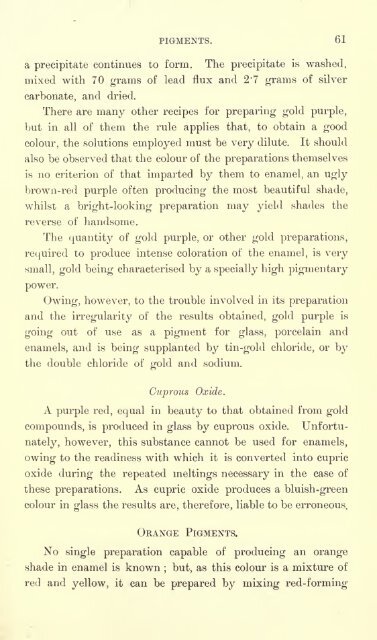Enamels and enamelling; an introduction to the preparation and ...
Enamels and enamelling; an introduction to the preparation and ...
Enamels and enamelling; an introduction to the preparation and ...
Create successful ePaper yourself
Turn your PDF publications into a flip-book with our unique Google optimized e-Paper software.
PIGMENTS. 61<br />
a precipitate continues <strong>to</strong> form. The precipitate is washed,<br />
mixed with 70 grams of lead flux <strong><strong>an</strong>d</strong> 27 grams of silver<br />
carbonate, <strong><strong>an</strong>d</strong> dried.<br />
There are m<strong>an</strong>y o<strong>the</strong>r recipes for preparing gold purple,<br />
but in all of <strong>the</strong>m <strong>the</strong> rule applies that, <strong>to</strong> obtain a good<br />
colour, <strong>the</strong> solutions employed must be very dilute. It should<br />
also be observed that <strong>the</strong> colour of <strong>the</strong> <strong>preparation</strong>s <strong>the</strong>mselves<br />
is no criterion of that imparted by <strong>the</strong>m <strong>to</strong> enamel, <strong>an</strong> ugly<br />
brown-red purple often producing <strong>the</strong> most beautiful shade,<br />
whilst a bright-looking <strong>preparation</strong> may yield shades <strong>the</strong><br />
reverse of h<strong><strong>an</strong>d</strong>some.<br />
The qu<strong>an</strong>tity of gold purple, or o<strong>the</strong>r gold <strong>preparation</strong>s,<br />
required <strong>to</strong> produce intense coloration of <strong>the</strong> enamel, is very<br />
small, gold being characterised by a specially high pigmentary<br />
power.<br />
Owing, however, <strong>to</strong> <strong>the</strong> trouble involved in its <strong>preparation</strong><br />
<strong><strong>an</strong>d</strong> <strong>the</strong> irregularity of <strong>the</strong> results obtained, gold purple is<br />
going out of use as a pigment for glass, porcelain <strong><strong>an</strong>d</strong><br />
enamels, <strong><strong>an</strong>d</strong> is being suppl<strong>an</strong>ted by tin-gold chloride, or by<br />
<strong>the</strong> double chloride of gold <strong><strong>an</strong>d</strong> sodium.<br />
Cuprous Oxide.<br />
A purple red, equal in beauty <strong>to</strong> that obtained from gold<br />
oxide. Unfortu-<br />
compounds, is produced in glass by cuprous<br />
nately, however, this subst<strong>an</strong>ce c<strong>an</strong>not be used for enamels,<br />
owing <strong>to</strong> <strong>the</strong> readiness with which it is converted in<strong>to</strong> cupric<br />
oxide during <strong>the</strong> repeated meltings necessary in <strong>the</strong> case of<br />
<strong>the</strong>se <strong>preparation</strong>s.<br />
As cupric oxide produces a bluish-green<br />
colour in glass <strong>the</strong> results are, <strong>the</strong>refore, liable <strong>to</strong> be erroneous.<br />
ORANGE PIGMENTS.<br />
No single <strong>preparation</strong> capable of producing <strong>an</strong> or<strong>an</strong>ge<br />
shade in enamel is known ; but, as this colour is a mixture of<br />
red <strong><strong>an</strong>d</strong> yellow, it c<strong>an</strong> be prepared by mixing red-forming
















